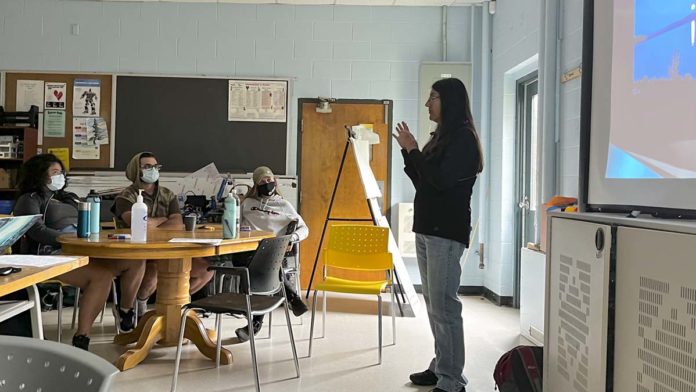Continuation of ‘Lighting the Fire Within’ project
M’CHIGEENG—UCCM Anishinaabe Police Service (UCCM APS) announced the launch of their culture and trauma informed curriculum last week. The resulting training falls in line with one of the components of the service’s Lighting the Fire Within project, which was designed to reduce risk factors associated with domestic violence and facilitate the creation of safer, stronger and healthier First Nations communities.
“The project name itself came from the idea that an individual’s spirit is being cultivated and nurtured again to become whole,” explained Taylor Sayers, director of corporate services. “Because when individuals go through traumatic experiences, there is a light that is diminished. We wanted to call it Lighting the Fire Within, because we all have that fire within ourselves. We realize that everyone has a role to play in lighting the fires within individuals, especially the service providers, and how we interact with the community matters.”
UCCM APS is offering this curriculum and training to the employees of the service with the intent of nurturing and cultivating fires within employees, but also within the community members they provide services to.
“We wanted the definitions for what culture is and what trauma is to be really reflective and inclusive,” Ms. Sayers said. “For culture, we’re referring not only to an individual’s race and ethnicity but we’re also including other variables such as beliefs, religion, gender and sexual orientation because that can impact an individual’s response to trauma and then it can actually cause trauma as well.”
Over the next two years subject matter experts will deliver training to meet the curriculum outcomes based on two focus areas: trauma and culture. The training to be delivered will allow for an understanding of trauma and how it impacts individuals, understanding how culture can impact responses to trauma, and methods to reduce further trauma in the delivery of policing services. Also, individuals will learn about the cultures, history, and past and present traumas experienced by the communities they serve. The training is comprised of both evidenced based and scenario-based learning.
Training sessions that include crisis intervention, cultural mindfulness, mental health leadership, forensic interviewing and trauma informed interviewing are being delivered by subject matter experts that have been identified to meet the learning outcomes and objectives from the culture and trauma-informed curriculum. Most importantly, the curriculum has a focus on the health and wellbeing of the employees themselves and a leadership component that focuses on emotional intelligence and change management.
The concept of healthy police and healthy communities is the foundation of the curriculum. “It really starts from within,” she added. “We need to be healthy ourselves. We need to build up more resilience and talk about problems or issues we may be going through.”
The curriculum includes specific training for leadership, looking at how leadership can help employees. It looks at some of the behaviours that an individual might have if they’re going through a difficult time and how to have those conversations. It also looks at the question, ‘how do you reduce stigma around mental health in policing?’
“Mental health, trauma and culture within the policing industry has been such a profound and much needed conversation. Understanding how to support employees who have experienced their own trauma and being proactive in reaching out to employees can only cultivate, sustain, and ensure trusting, positive relationships within the police service and with our communities,” stated Chief of Police James Killeen.
The curriculum was developed over the past year-and-a-half, through a review of existing cultural and trauma informed service models and training, and inquiries and reports completed within the policing sector, including Justice Iacobucci’s 2013 report, ‘Police Interactions with People in Crisis and Use of Force,’ the 2018 Thunder Bay Police Services Board Investigation, and the 2014 Ontario Human Rights Commission on Police Use of Force and Mental Health. “There are a number of reports that have been done in which common themes were evident across all of them,” Ms. Sayers said.
From that information, she identified common themes across all of the reports and recommendations and looked at what training that UCCM Police could provide internally.
Officers themselves contributed to the development process. “They were provided with a questionnaire on what they would like to learn so they were actually part of building of the curriculum as well, which was very important to us,” Ms. Sayers said. “We also went to our advisory committee, which is comprised of service partners we work with and people who have experienced interpersonal violence or trauma. Our evaluation team, comprised of Dr. Lorrilee McGregor and Dr. Marion Maar, both with NOSM University, is also a part of the advisory committee as well as individuals with knowledge of interpersonal violence as well. They all provided input to the actual curriculum itself.”
Officers have already participated in a cultural training component. “We did do our first group and we’re booking two additional sessions with our facilitator so we can try and allow for training as many people as possible,” said Ms. Sayers. Feedback was great with officers wanting to see more of the training, she said. Leadership has also participated in a change management session already.
An evaluation team will look at successes and potential gaps in the curriculum and ask the questions, “’Was it good training that we provided. Did it have an impact in our community?’ We will have that available well after the project is completed,” she said.
“It’s amazing to see how it came from an idea a number of years ago, from 2018 when we first did this proposal to where it is now, to finally be able to deliver this training, this curriculum and the other parts of the Lighting the Fire Within project as well,” Ms. Sayers said.





